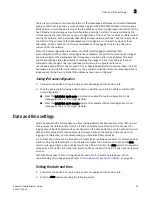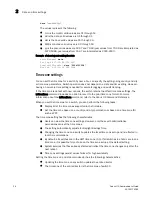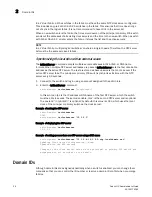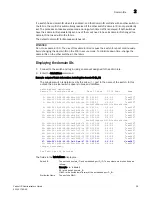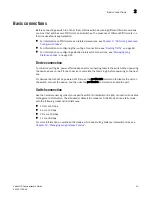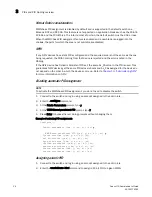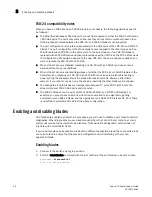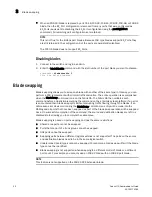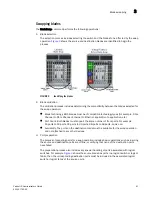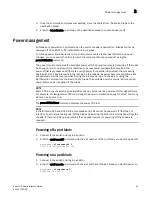
Fabric OS Administrator’s Guide
39
53-1001763-02
Ports
3
Clearing PID binding
1. Connect to the switch and log in using an account assigned to the admin role.
2. Enter the wwnAddress -unbind command to clear the PID binding for the specified WWN.
Showing PID assignments
1. Connect to the switch and log in using an account assigned to the admin role.
2. Based on what you want to display, enter the appropriate command:
•
wwnAddress –show displays the assigned WWN-PID bindings.
•
wwnAddress –findPID
wwn
displays the PID assigned to the device WWN specified.
Ports
Because enterprise-class platforms contain interchangeable port blades, their procedures differ
from those for fixed-port switches. For example, fixed-port models identify ports only by the port
number, while enterprise-class platforms identify ports by
slot/port
notation
.
NOTE
For detailed information about the Brocade 48000 director, and the Brocade DCX and DCX-4S
enterprise-class platforms, see the
Brocade 48000 Hardware Reference Manual
, the
Brocade DCX
Data Center Backbone Hardware Reference Manual, and the Brocade DCX-4S Data Center
Backbone Hardware Reference Manual
, respectively.
The different blades that can be inserted into a chassis are described as follows:
•
Control processor blades (CPs) contain communication ports for system management, and are
used for low-level, platform-wide tasks. In the Brocade 48000, CPs are used for intra-platform
switching.
•
Core blades in the Brocade DCX (CORE8) and DCX-4S (CR4S-8) are used for intra-chassis
switching as well as interconnecting two Brocade DCX enterprise-class platforms.
•
Port blades are used for host, storage, and interswitch connections.
•
AP blades are used for Fibre Channel Application Services and Routing Services, iSCSI
bridging, FCIP, Converged Enhanced Ethernet, storage virtualization, and encryption support.
NOTE
On each port blade, a particular port must be represented by both slot number and port number.
The Brocade 48000 has 10 slots that contain control processor, port, and application (AP) blades:
•
Slot numbers 5 and 6 contain control processor blades.
•
Slot numbers 1 through 4 and 7 through 10 contain port and AP blades.
The Brocade DCX has 12 slots that contain control processor, core, port, and AP blades:
•
Slot numbers 6 and 7 contain CPs.
•
Slot numbers 5 and 8 contain core blades.
•
Slot numbers 1 through 4 and 9 through 12 contain port and AP blades.
Summary of Contents for 53-1001763-02
Page 1: ...53 1001763 02 13 September 2010 Fabric OS Administrator s Guide Supporting Fabric OS v6 4 0 ...
Page 4: ...iv Fabric OS Administrator s Guide 53 1001763 02 ...
Page 24: ...xxiv Fabric OS Administrator s Guide 53 1001763 02 ...
Page 28: ...xxviii Fabric OS Administrator s Guide 53 1001763 02 ...
Page 32: ...xxxii Fabric OS Administrator s Guide 53 1001763 02 ...
Page 40: ...xl Fabric OS Administrator s Guide 53 1001763 02 ...
Page 42: ...2 Fabric OS Administrator s Guide 53 1001763 02 ...
Page 54: ...14 Fabric OS Administrator s Guide 53 1001763 02 High availability of daemon processes 1 ...
Page 74: ...34 Fabric OS Administrator s Guide 53 1001763 02 Basic connections 2 ...
Page 102: ...62 Fabric OS Administrator s Guide 53 1001763 02 Audit log configuration 3 ...
Page 214: ...174 Fabric OS Administrator s Guide 53 1001763 02 Management interface security 7 ...
Page 228: ...188 Fabric OS Administrator s Guide 53 1001763 02 Brocade configuration form 8 ...
Page 276: ...236 Fabric OS Administrator s Guide 53 1001763 02 Creating a logical fabric using XISLs 10 ...
Page 404: ...364 Fabric OS Administrator s Guide 53 1001763 02 ...
Page 440: ...400 Fabric OS Administrator s Guide 53 1001763 02 Performance data collection 17 ...
Page 480: ...440 Fabric OS Administrator s Guide 53 1001763 02 F_Port masterless trunking 19 ...
Page 494: ...454 Fabric OS Administrator s Guide 53 1001763 02 Buffer credit recovery 20 ...
Page 574: ...534 Fabric OS Administrator s Guide 53 1001763 02 Hexadecimal overview E ...

